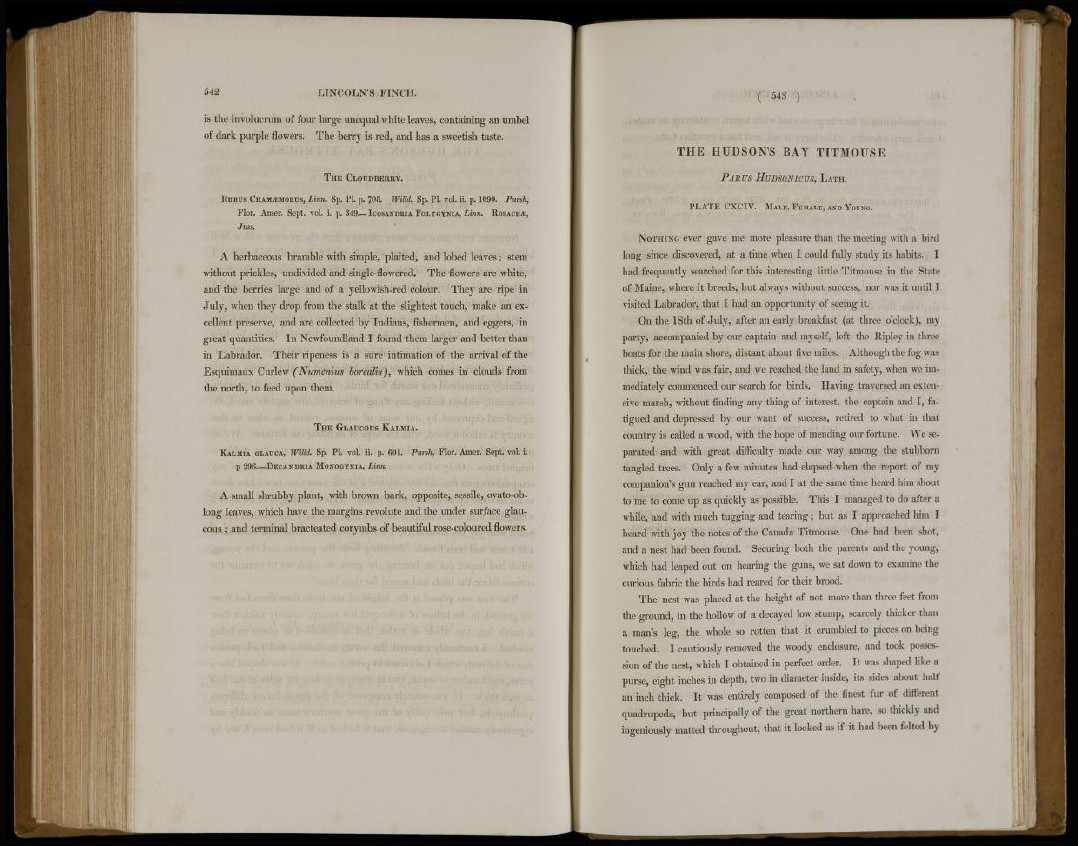
LINCOLN'S FINCH.
is the involucrum of four large unequal white leaves, containing an umbel
of dark purple flowers. The berry is red, and has a sweetish taste.
THE CLOUDBERRY.
RUBUS CHAMiEMORUS, Linn. Sp. PI. p. 708. Willd. Sp. PI. vol. ii. p. 1090. Pursh,
Flor. Amer. Sept. vol. i. p. 349.—ICOSANDRIA POLYGYNIA, Linn. ROSACEA,
Juss.
A herbaceous bramble with simple, plaited, and lobed leaves; stem
without prickles, undivided and single-flowered. The flowers are white,
and the berries large and of a yellowish-red colour. They are ripe in
July, when they drop from the stalk at the slightest touch, make an excellent
preserve, and are collected by Indians, fishermen, and eggers, in
great quantities. In Newfoundland I found them larger and better than
in Labrador. Their ripeness is a sure intimation of the arrival of the
Esquimaux Curlew (Numenius boredlis), which comes in clouds from
the north, to feed upon them.
THE GLAUCOUS KALMIA.
KALMIA GLAUCA, Willd. Sp. P L vol. ii. p. 601. Pursh, Flor. Amer. Sept. vol. i.
p 296 DECANDRIA MONOGYNIA, Linn.
A small shrubby plant, with brown bark, opposite, sessile, ovato-oblong
leaves, which have the margins revolute and the under surface glaucous
; and terminal bracteated corymbs of beautiful rose-coloured flowers.
( 543 )
T H E H U D S O N ' S B A Y T I T M O U S E .
PARUS HUDSONICUS, LATH.
P L A T E C X C I V . MALE, FEMALE, AND YOONG.
NOTHING ever gave me more pleasure than the meeting with a bird
long since discovered, at a time when I could fully study its habits. I
had frequently searched for this interesting little Titmouse in the State
of Maine, where it breeds, but always without success, nor was it until I
visited Labrador, that I had an opportunity of seeing it.
On the 18th of July, after an early breakfast (at three o'clock), my
party, accompanied by our captain and myself, left the Ilipley in three
boats for the main shore, distant about five miles. Although the fog was
thick, the wind was fair, and we reached the land in safety, when we immediately
commenced our search for birds. Having traversed an extensive
marsh, without finding any thing of interest, the captain and I, fatigued
and depressed by our want of success, retired to what in that
country is called a wood, with the hope of mending our fortune. We separated
and with great difficulty made our way among the stubborn
tangled trees. Only a few minutes had elapsed when the report of my
companion's gun reached my ear, and I at the same time heard him shout
to me to come up as quickly as possible. This I managed to do after a
while, and with much tugging and tearing; but as I approached him I
heard with joy the notes of the Canada Titmouse. One had been shot,
and a nest had been found. Securing both the parents and the young,
which had leaped out on hearing the guns, we sat down to examine the
curious fabric the birds had reared for their brood.
The nest was placed at the height of not more than three feet from
the ground, in the hollow of a decayed low stump, scarcely thicker than
a man's leg, the whole so rotten that it crumbled to pieces on being
touched. I cautiously removed the woody enclosure, and took possession
of the nest, which I obtained in perfect order. It was shaped like a
purse, eight inches in depth, two in diameter inside, its sides about half
an inch thick. It was entirely composed of the finest fur of different
quadrupeds, but principally of the great northern hare, so thickly and
ingeniously matted throughout, that it looked as if it had been felted by